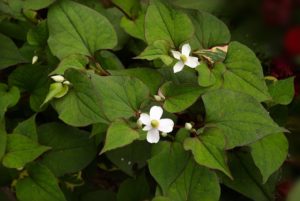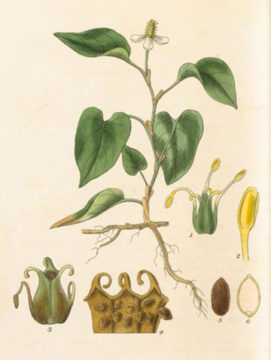FAMILY :: SAURURACEAE
$100 pesos
Vietnamese diep cá, the Chinese ZHE ERGEN or YU-XING-CAO, Japanese DOKUDAMI, and the English FISHMINT: Recently, while visiting a nearby nursery, I saw the ornamental version of this plant (called “Chameleon”) described as having a “citrus scent.” The Chinese name, however, means “fish-smell herb.” Take your choice, but keep in mind that eating the raw leaf will impart a fish-smell to your breath. The Japanese name, DOKUDAMI is more descriptive of its medical properties, meaning “poison blocking herb.”
 It is used traditionally for treating infections of the upper respiratory tract and has been used externally as a poultice for skin cancer, snake bites, boils and psoriasis. It is diuretic, antifungal, antibacterial, anti-inflammatory, antiviral.
It is used traditionally for treating infections of the upper respiratory tract and has been used externally as a poultice for skin cancer, snake bites, boils and psoriasis. It is diuretic, antifungal, antibacterial, anti-inflammatory, antiviral.
 Likes a cool, shaded situation with rich, moist soil. It is ornamental, and this variety has many small white flowers that appear all summer long. Its leaves are dark green with a slight purple edging. It grows well in Vallarta.
Likes a cool, shaded situation with rich, moist soil. It is ornamental, and this variety has many small white flowers that appear all summer long. Its leaves are dark green with a slight purple edging. It grows well in Vallarta.
Culinarily the leaves and roots are eaten fresh and are called in China chu p’i ku (pig thigh). In parts of India, Houttuynia cordata is cooked with vegetables or served raw in salads. The roots are sometimes ground and used along with chile peppers and tamarind in chutneys. Vietnamese cooks use it in grilled meat dishes and noodle salads; it also shows up in goi cuon, a Vietnamese dish featuring stir-fried beef.
Because of how pungent it is, cooks use it in small amounts. The leaves are eaten in China’s Sichuan province while people from Guizhou eat the roots.
An ornamental version, with mottled white and red on a dark green base, is sold in some nurseries as HOUTTUYNIA CORDATA ‘Chameleon.’